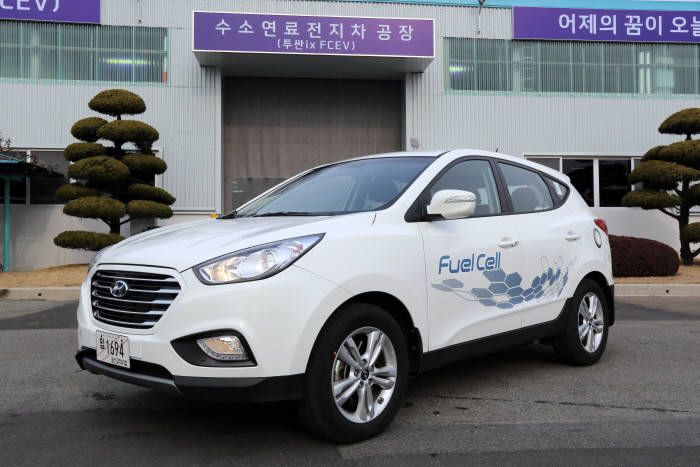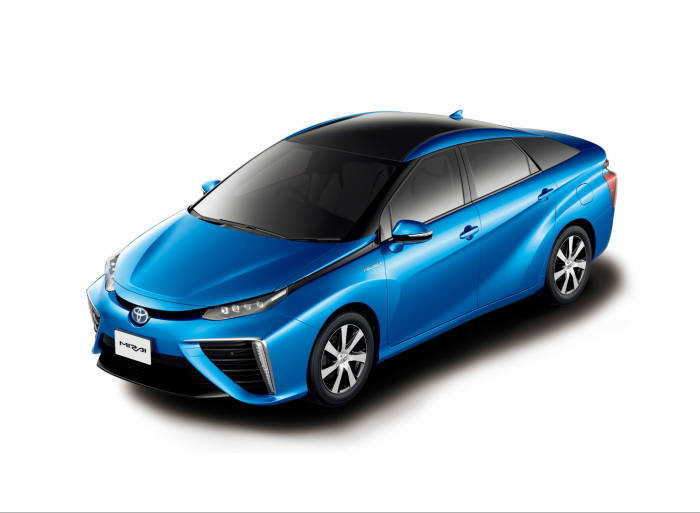HMC lowered the price of the Tucson ix fuel cell electric vehicle (FCEV), a next-generation environment-friendly car, by more than 40%. It is an aggressive price strategy to popularize the FCEV. In particular, as the sedan-type FCEV ‘Mirai,’ released by Toyota at the end of last year, was on a rapid rise in the market, HMC’s initiative as the ‘world’s first auto maker to produce the FCEV’ was threatened. This price cut is regarded as a countermove. The competition between HMC and Toyota for expanding the supply of FCEVs and preoccupying the market is forecast to further intensify.

HMC (CEO Chung Mong-koo) announced that the company would cut the domestic selling price of the ‘Tucson ix FCEV,’ which is priced at KRW150 million, by 43.3% to KRW85 million starting February 2. HMC is also considering its overseas selling price, and added that it would determine the size and time of the price cut in consideration of market conditions.
HMC, which was the first global auto maker to build the system for mass-producing the FCEV in 2013, expects that this price cut would enable the company to further popularize the car both at home and abroad, and continue its leadership in global competition.
HMC regards Japan’s Toyota as its biggest competitor. Just a month after it released the sedan-type FCEV Mirai at the end of last year, Toyota sold 1500 cars. The figure is far more than half of its annual production plan for this year. Accordingly, Toyota is planning to sell 700 Mirai’s this year, and greatly increase its production to 2000 in 2016 and 3000 in 2017. In particular, as the Mirai was priced at a little over KRW65 million due to its platform optimized for the FCEV, it has been deemed to be far more price-competitive than HMC since its development stage.

HMC’s aggressively cutting the price by more than 40% implies that its competition with the Toyota Mirai is a top priority. However, the price difference between the two cars still exceeds KRW17 million. HMC says that, considering that Japanese auto makers are benefiting from the weak Yen and the prices of SUVs are ordinarily higher than those of sedans, the price difference between the two cars is not that big. In particular, besides the Tucson ix FCEV’s title as the first mass-produced FCEV in the world, the company added, it is outstanding in terms of noise, interior, utilization of storage space and finishing materials.
HMC has sold about 200 or so FCEVs since 2013. In Europe the company is selling them to governments, local governments and public institutions, and in the US market it is capitalizing on lease to sell them to general customers. “As the price of the Tucson ix FCEV has been cut steeply, it will become more affordable and the FCEV will become more popular in Korea,” said an HMC insider. “In particular, the gradual expansion of the hydrogen charging infrastructure and increasing sales are expected to further accelerate the popularization of the FCEV.”
As the FCEV emits no exhaust gas except water, and has a longer range than electric vehicles that has a short per-charge range, it is highlighted as a representative next-generation environment-friendly car. The Tucson ix FCEV comes with the 100kW fuel cell stack, which was independently developed by HMC, the 100kW driving motor and the 24kW high-voltage battery, and it can be driven 415㎞ per charge. The HMC Group is planning to increase the FCEV lineup to 2 models by 2020 and solidify its market leadership.
Meanwhile, this decision was made in full compliance with the government policy to popularize environment-friendly cars including the FCEV. In the same context, the No. 1 auto maker in Korea is concentrating on creation of the FCEV industrial ecosystem as well as the automotive startup support as the major projects of the Gwangju Creative Economy Innovation Center, which was recently launched jointly by Gwangju and the HMC Group.